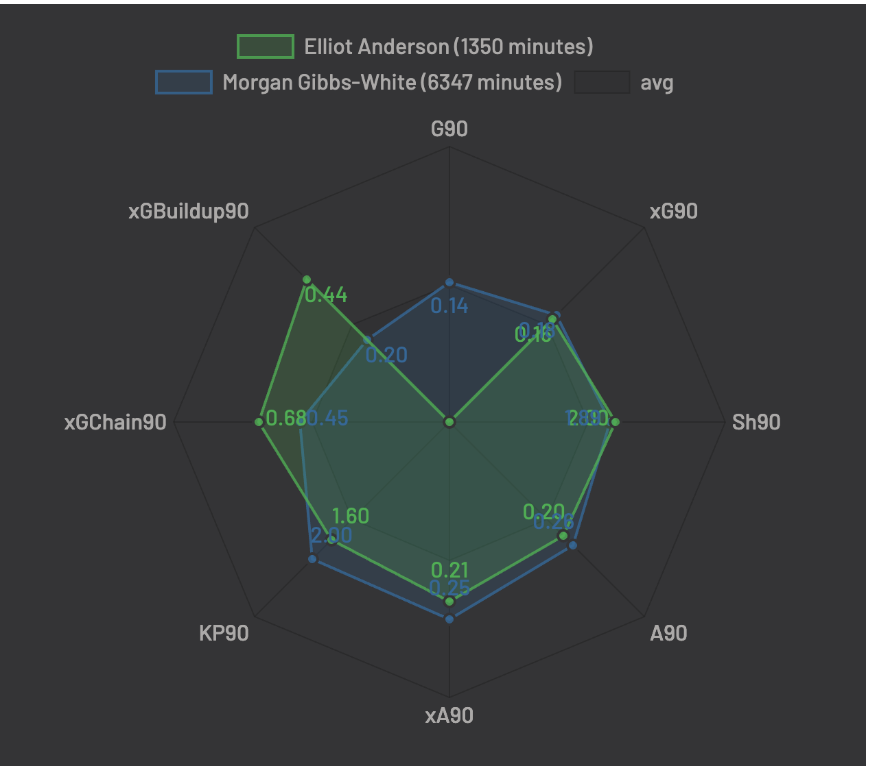Elliot Anderson and the Reality of PSR Transfers
Many eyebrows were raised at the end of June when a specific group of Premier League clubs began buying and selling players to each other just before the end of the football fiscal year. Chelsea, Aston Villa, Newcastle, Everton, and Nottingham Forest were all in jeopardy of breaching the Premier League’s Profit and Sustainability Regulations (PSR), and the latter two clubs had already been punished for prior infringements during the 2023/24 season.
And so, these clubs found a creative and, more importantly, legal solution to this problem by selling each other homegrown players who they could mark as pure profit in the books. Few of those transfers were bigger than that of 21-year-old midfielder Elliot Anderson’s move from Newcastle to Nottingham Forest, but let’s first discuss the requisite financial context to fully understand all angles of his record-breaking arrival at the City Ground.
A key concept to understand in this matter is amortization, an accounting process that allows you to pay for an expense over the maturation period of that debt, as opposed to all at once when the transaction is made. For most football clubs, this means paying the transfer fee of an incoming player to the selling club in installments over the course of that new player’s contract, therefore lessening the immediate financial burden on the club and appeasing the footballing overlords in terms of net spend.
Jota Silva amongst Vitória’s squad:
-Most goals (11)
-Most goal contributions (16)
-Most shots per game (2.9)
-Most big chances created (8)
-Most successful dribbles per game (1.3)@kevinaraujof takes a look at the “Portuguese Jack Grealish.” https://t.co/DmVIoEA9py pic.twitter.com/PFdpon5Nv2
— Breaking The Lines (@BTLvid) July 5, 2024
Chelsea notoriously abused this upon Todd Boehly’s arrival, giving their flurry of new singings absurdly long contracts so they could amortize those fees across nearly a decade, resulting in smaller installments, and therefore the ability to keep spending ludicrous money without breaching PSR. They went overboard, however, and recently sold a hotel essentially to themselves in order to avoid a points deduction, because that’s perfectly fair apparently. I digress.
PSR only allows clubs to lose a certain amount of money across a rolling three-year period which shifts at the end of every fiscal season on June 31st. For example, Everton’s first points deduction was for going beyond the allowed losses for the three-year period ending in June 2022, while their second points deduction was for the three-year period ending in June 2023.
Therefore, clubs must assess their losses over the previous three years every June to ensure they are not left stranded on the wrong side of the line, and this year there were quite a few who found themselves in vulnerable positions and needed to find a way around it before time ran out.
Here’s how they did it: although you can amortize the cost of a transfer if you’re the buying club, the selling club can count the entire sum towards their books for that season. This means that in the short term, selling is much more beneficial than buying is harmful.
In his first season in European football, Murillo has claimed Nottingham Forest’s Player of the Season award.@KingArinze on Murillo: https://t.co/yHAOx0AvDG@The_Own_Goal on Forest: https://t.co/Hh9D9RJ8AK pic.twitter.com/qA5I23BoWA
— Breaking The Lines (@BTLvid) May 18, 2024
And so, these clubs worked together to sell each other academy players whom they were not paying any amortized transfer fees for, essentially allowing the clubs to report as much profit as possible from those sales and skirt around PSR. Chelsea sold Ian Maatsen to Aston Villa, who in return sold Omari Kellyman to Chelsea. Everton sold Lewis Dobbin to Aston Villa, who in return sold Tim Iroegbunam to Everton. And of course, Nottingham Forest sold Odysseas Vlachodimos to Newcastle United, who in return sold Elliot Anderson to Nottingham Forest.
Some claimed that the fees paid for all these players were significantly inflated to make up for whatever gap existed between the clubs’ realized losses and allowed losses under PSR, and although that may be true, it is extremely important to note that, unlike Chelsea’s hotel, this is not a loophole or a get out of jail free card and it does not stop these clubs from being susceptible to PSR breaches in the future.
These transfers are a legal and calculated accounting risk. Due to these inflated transfer fees, their amortized costs will go up significantly, making all these clubs more susceptible to PSR breaches later on. This concept of deferring risk is not new to sports at all, as the NFL’s contract re-structuring framework provides a clear example of sports properties delaying costs and risks to later seasons.
All these transfers did from a financial perspective was kick the can down the road… well, other than cause significant changes to all these players’ careers that likely wouldn’t have happened otherwise. I think it’s very safe to say that Elliot Anderson never would’ve left Newcastle United if the Magpies weren’t staring down the barrel of Richard Masters’ point-deduction musket.
Yankuba Minteh joined Newcastle for €7m only to be immediately loaned out to Feyenoord, where he has shown promising signs in the Eredivisie.
Does the Gambian winger have what it takes to challenge for a place in Newcastle’s first team?
@234programmer: https://t.co/cTHJiWuSgQ pic.twitter.com/64Dqo9ektN
— Breaking The Lines (@BTLvid) February 21, 2024
His former teammate Kieran Trippier said back in 2023, “It’s crazy, really, how good he is. He’s got a massive future ahead of him.” Many Newcastle fans viewed him as the next local hero, as Anderson grew up in nearby Whitley Bay and joined the Newcastle academy at age 8 from Wallsend Boys Club, who also nurtured Geordie legends such as Alan Shearer and Peter Beardsley.
Anderson is a player that Newcastle manager Eddie Howe certainly wanted to keep hold of, as he remarked to Sky Sports, “The PSR issues we faced in June were really strong and really difficult for us… Very sad to lose two exciting young players in Elliot Anderson and Yankuba Minteh who I think are big losses for us.”
From a Forest perspective, they certainly did not expect to be able to pry the former out of Tyneside but jumped on the opportunity when it arose. Anderson registered a higher Progressive Carries per 90 number than any other U23 center midfielder who played at least 1000 minutes in Europe’s Top 5 Leagues, UCL, or UEL. His numbers look very promising for a progressive/attacking central midfielder.

However, concerns about his similarity to Nottingham Forest’s pre-existing star Morgan Gibbs-White have been raised. Last season, manager Nuno Espirito Santo deployed a standard 4-2-3-1 formation in which Gibbs-White shone at the 10 with Orel Mangala and club captain Ryan Yates occupying the two center-midfield positions behind him.
Mangala has departed for Lyon in France this summer, though, leaving a vacant space that Anderson could potentially fill. However, fans of Bristol City, where Anderson spent a phenomenal season on loan in 2021/22, would tell you he’s best playing out on the left, while many Newcastle fans would say he’s best playing exactly where Gibbs-White has been for the past few seasons at the City Ground. The data also suggests that they have similar strengths, goals aside.

In Forest’s final pre-season game against Olympiacos, Anderson started on the left flank where one-time Chelsea starlet Callum Hudson-Odoi featured last season, and I don’t expect him to usurp the 23-year-old winger who scored 8 goals from just 2.7 xG.
Forest also believe that Ivorian center-midfielder Ibrahim Sangaré will play a much bigger role this season after his big £30m move last summer, so with LW, CAM, and CM all seemingly covered, it’s possible that Anderson, Forest’s record signing, may not even be in the XI come the opening day of the season.
So the question arises, did this £35m transfer make sense for Nottingham Forest from a footballing perspective, or was it only executed for the sake of PSR? With Vlachodimos going the other way for a reported £12.8m, these two transfers were mutually beneficial, at least financially, for both Forest and Newcastle.
By processing these transfers separately, Forest reported £9.4m in profit for the 2023/24 fiscal year, whereas a player plus cash swap deal would’ve resulted in a £3.4m loss for the Midlands club. Newcastle were able to report £35m in profit as opposed to £22.2m in profit, an increase which was likely needed to help mitigate their heavy spending in prior seasons, and added a new face to their injury-riddled and aging goalkeeping corp in the process.
Nottingham Forest have beaten Manchester United for the first time since December 17, 1994, with Nicolas Dominguez and Morgan Gibbs-White scoring in a 2-1 win at the City Ground.@tabuteauS on Dominguez: https://t.co/ZmPB0rblV8@tabuteauS on Gibbs-White: https://t.co/cLd15kIjC7 pic.twitter.com/PtpON9oHIe
— Breaking The Lines (@BTLvid) December 30, 2023
In my opinion, the signing of Anderson makes sense not only financially, but also on the pitch for Nottingham Forest. Although his role in Nuno’s team may not yet be apparent, his versatility is one of the traits his former manager Howe valued most in him as a player. “What I love about Elliot is he’s versatile,” Howe told The Athletic last year. “He can play wide, he can play inside.”
Having an adaptable player with a ceiling as high as Anderson’s surely can’t be viewed as a negative, and with no winter break during the upcoming campaign, his ability to cover different positions may become crucial for Forest’s squad depth as they look to avoid the drop for a third-year running. And, should Gibbs-White’s inevitable departure from the club come sooner than later, Anderson is a tailor-made replacement already raring to go.
Although PSR workaround transfers like this one may look a bit dodgy on the surface, these clubs have found clever and creative ways to balance their books and improve their squads at the same time. With financial regulations becoming increasingly imposed on clubs without the year-on-year revenue of “The Big Six”, taking advantage of every accounting tool in the box is a must until the PSR reform that is desperately needed finally comes about, and the Premier League’s glass ceiling finally breaks.
By: Garrett Post / @ParrettGost
Featured Image: @GabFoligno / David Rogers / Getty Images
